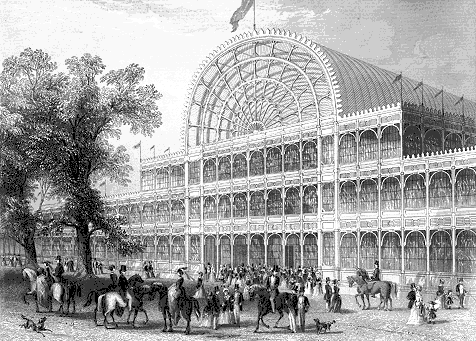 |
| The Crystal Palace, newly re-sited on Sydenham Hill, 1854 |
Plans for Crystal Palace replica
This article from a couple of weeks ago, which I had originally intended to post at the time(!), details the tantalising prospect of a once-major London landmark making a reappearance in its old location. That landmark? The Crystal Palace!
 |
| The original façade; The Great Exhibition 1851 |
Built in Hyde Park in 1851 to house the Great Exhibition (a sort of Victorian World's Fair), The Crystal Palace was a symbolically massive 1,851ft long and 128ft high and made out of the then new cast plate glass. Although originally intended to be a temporary structure, the architect Joseph Paxton's use of innovative materials and modular design - not to mention the vast size of the building - meant that at the end of the 6 month Exhibition it was decided that The Crystal Palace would be dismantled and rebuilt on Penge Common at Sydenham Hill in Bromley, south-east London (eventually lending its name to the park and the surrounding area). In the event it was not only rebuilt but also substantially extended and redesigned, to become the building we remember today.
Over the next 82 years The Crystal Palace would play host to many hundreds of expositions, shows, concerts, exhibitions, festivals and meetings; it moonlighted as a Royal Navy training base during the First World War and played host to the original Imperial War Museum from 1920 to 1924.
Having been saved from potential destruction in 1913 when the original owners declared bankruptcy and restored to its 19th century glory in the 1920s, disaster struck on the night of the 30th November 1936 when an explosion in a ladies' cloakroom caused an initially small fire in one of the offices. A combination of high winds, wooden flooring that ran throughout the building and the many flammable objects - including fireworks - stored within meant that very quickly the whole place was ablaze and despite the best efforts of 400 fireman and 89 fire engines the entire structure burned to the ground in a matter of hours. Contemporary reports show that the glow from the flames could be seen in eight counties; 100,000 people - including Winston Churchill (who later said "This is the end of an age") - turned up to watch the battling firemen trying to save it. Unfortunately the building's insurance cover was not enough to meet the proposed cost of rebuilding, which was put at £2,000,000 (£111,000,000 in today's money). Only the north water tower escaped destruction (the south tower also survived the fire but was dismantled shortly thereafter when it was discovered fire damage had made it structurally unsafe) - at least until 1941 when it was demolished for reasons unknown, although it was thought to possibly offer a handy landmark to German bombers. The grounds were also used to house radar manufacturing facilities.
Now, in 2013, there seems to be a chance (albeit slight) that an exact copy of The Crystal Palace may rise Phoënix-like, as it were, on the original site thanks to a Chinese developer. Quite what their angle is in all this (beyond the money) I'm not sure - I'm usually slightly dubious about Far East-backed concepts like this (hence the reason, apart from the somewhat questionable taste of it, that I haven't featured the proposed "Titanic II" replica stories that have been doing the rounds on the Internet in recent months). Still it would seem that Crystal Palace Park is in need of redevelopment and the glass-and-iron wonder that gave it its name, glinting in the sunlight atop Sydenham Hill once again (I can just imagine it!) might be just the ticket (although it's early days yet, still something to keep an eye on)!






